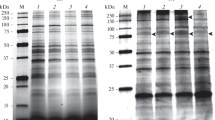Summary
Setaria digitata, a bovine filarial parasite is used as a laboratory model for filariasis. The studies showed that considerable amount of biochemically and immunologically active materials are present on the surface of the parasite. The effect of Triton X-100 on the surface of the parasite, when it is used to separate the surface associated materials, is not known. Treatment with Triton X-100 enhances the amount of ES protein released into the medium. The electron microscopic study of S. digitata wall showed that structure of the surface is similar to that of W. bancrofti. There are striations, annulations and button like bosses on the filarial surface. On treatment with Triton X-100 the electron dense cloudy layer on the surface was disappeared. The surface appeared to be suitable for hosting secreted molecules on the surface.
Similar content being viewed by others
References
Araujo, A. C., Figueredo-Silva, J., Souto-Padrón, T., Dreyer, G., Norões, J., De Souza, W. (1995): Scanning electron microscopy of adult Wuchereria bancrofti (Nematoda: Filarioidea). J. Parasitol., 81: 468–474
Bailey, J. W., Hightower, A. W, Eberhard, M. L., Lammie, P. J. (1995): Acquisition and expression of humoral reactivity to antigens of infective stages of filarial larvae. Parasite. Immunol., 17: 617–623
Blaxter, M. L., Page, A. P., Rudin, W., Maizels, R. M. (1992): Nematode surface coats: actively evading immunity. Parasitol. Today., 8: 243–247
Bright, J. J., Raj, R. K. (1991): Isolation and analysis of surface antigens of filarial nematode Setaria digitata. Indian. J. Exp. Biol., 29: 725–729
Bright, J. J., Raj, R. K. (1992): Antigenic analysis of purified surface antigens of filarial nematode Setaria digitata. Indian. J. Exp. Biol., 30: 362–366
Bright, J. J., Raj, R. K. (1994): Ontogenetic transformation of surface epitope expression, an adaptive immunoevasive strategy of filarial parasites. Indian. J. Exp. Biol., 32: 49–54
Decruse, S. W., Raj, R. K. (1990): Histological studies on female Setaria digitata (von Linstow 1906), a filaria of bovine (Bos indicus). Proceedings of Indian Academy of Science (Animal Science) 99(2): 103–111
Devi, C. M., Raj, R. K. (1996): Histological changes in the spleen of BALB/C mice caused by excretory-secretory protein(s) of Setaria digitata (von Linstow). Indian. J. Exp. Biol., 34: 32–36
Dhas, K. P., Raj, R. K. (1995): Epitope specific monoclonal antibodies from heterologous antigen for immunodiagnosis of filariasis. Indian. J. Med. Res., 101: 183–189
Fang, T. K., Donaldson, R. P., Vigil, E. L. (1987): Electron transport in purified glyoxysomal membranes from castor bean endosperm. Planta., 172: 1–13
Hawking, F. (1978): Diethylcarbamazine WHO/ONCHO/78.142.1.
James, P. H., John, R. G., Maizels, R. M. (2009): Helminth immunoregulation: The role of parasite secreted proteins in modulating host immunity. Mol. Biochem. Parasitol., 167: 1–11
John, L., Raj, R. K. (1998): Immune response of electroeluted detergent soluble 29 kDa antigen from Setaria digitata (von Linstow). Indian. J. Exp. Biol., 36: 862–866
Kagei, N. (1960a): Morphological studies on thread worm, Filarioidea. Report 1. Morphological structure of Setaria cervi. Acta. Med. Univ. Kagoshima., 2: 142–149
Kagei, N. (1960b): Morphological studies on thread worm, Filarioidea. Report 2. On the microstructure of body wail and uterus of adult Setaria cervi. Acta. Med. Univ. Kagoshima., 2: 150–157
Kagei, N. (1963): Morphological studies on thread worm, Filarioidea. Report 5. On the microstructure of male of Litomosoides carinii (Travassos, 1919), Filaria of cotton rat. Acta. Med. Univ. Kagoshima., 5: 43–53
Kwan-Lim, G. E., Gregory, W. F., Selkirk, M. E., Partono, F., Maizels, R. M. (1989): Secreted antigens of filarial nematodes: a survey and characterization of in vitro excreted/secreted products of adult Brugia malayi. Parasite. Immunol., 11: 629–654
Madathiparambil, M. G., Kaleysa, K. N., Raghavan, K. (2009): A diagnostically useful 200-kDa protein is secreted through the surface pores of the filarial parasite Setaria digitata. Parasitol. Res., 105: 1099–1104
Murugan A., Kaleysaraj R. (1991): In vitro release of biologically active materials from the bovine filarial parasite Setaria digitata. Indian. J. Exp. Biol., 29: 1047–1050
Muthian, G., Pradeep, C. G., Sargapradeep, K., Kaleysaraj, R., Bright, J. J. (2006): Setaria digitata secreted filarial lipids modulate IL-12 signaling through JAK-STAT pathway leading to the development of Th1 response. Exp. Parasitol., 114: 193–203
Oliveira-Menezes, A., Lins, R., Norões, J., Dreyer, G., Lanfredi, R. M. (2007): Comparative analysis of a chemotherapy effect on the cuticular surface of Wuchereria bancrofti adult worms in vivo. Parasitol. Res., 101: 1311–1317
Pokharel, D. R., Rai, R., Nandakumar, K. K., Reddy, M. V., Rathaur, S. (2006): Vaccination with Setaria cervi 175 kDa collagenase induces high level of protection against Brugia malayi infection in jirds. Vaccine., 24: 6208–6215
Sheng, Y. L. (1958): The differentiation of Setaria cervi and Setaria digitata, the two species commonly found in ruminants in Asia (Demonstration). Trans. R. Soc. Trop. Med. Hyg., 52: 11
Sheng, Y.L. (1959): A revision of the nematode genous Setaria Viborg, 1795, its hostparasite relationship, speciation and evolution. J. Helminthol., 33:1–98
Sugunan, V. S., Raj, R. K. (1990): Excretory/secretory antigens from a bovine filarial parasite cross react with human antifilarial antibodies. Indian. J. Exp. Biol., 28: 1124–1127
Author information
Authors and Affiliations
Corresponding author
About this article
Cite this article
Madathiparambil, M.G., Kavitha Raj, N.K., Linda, J. et al. Surface of the filarial parasite Setaria digitata and the structural changes on treatment with Triton X-100. Helminthologia 48, 17–22 (2011). https://doi.org/10.2478/s11687-011-0004-8
Received:
Accepted:
Published:
Issue Date:
DOI: https://doi.org/10.2478/s11687-011-0004-8




